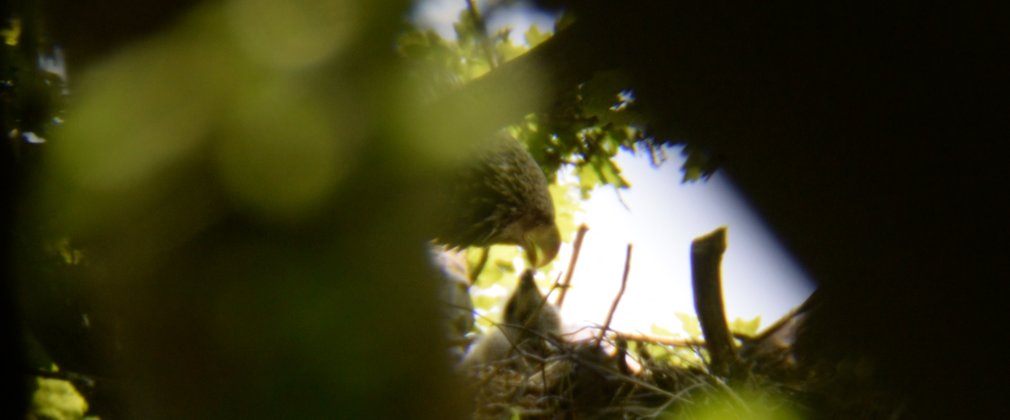
First white-tailed eagle in 240 years born in England
In a landmark moment for conservationists, the first white-tailed eagle for over 240 years has fledged from a nest in the wild in England. The chick is the first successful breeding attempt of the white-tailed eagles released by Forestry England and the Roy Dennis Wildlife Foundation’s project to return this lost species to England.
White-tailed eagles are Britain’s largest birds of prey with a wingspan of up to 2.5 meters and were once widespread across England. Human persecution caused their extinction with the last pair breeding in southern England in 1780. In 2019, Forestry England and the Roy Dennis Wildlife Foundation began a reintroduction programme to restore these iconic birds to the English landscape.
Two of the birds released by the project in 2020 – female G405, originally translocated from the Outer Hebrides and male G471, from north-west Sutherland – reared the male chick earlier this summer. The location of the nest, on private land with no public access, is not being disclosed for the welfare of the birds and to prevent any disturbance to them or the landowner either this year or if the birds return to breed at the same location.
The chick was ringed and fitted with a satellite tag by licensed ornithologists from the Roy Dennis Wildlife Foundation enabling the project team to track this historic bird’s daily progress through its life.
Roy Dennis MBE, Founder of the Roy Dennis Wildlife Foundation, said:
“This is a very special moment for everyone who has worked on, supported and followed this ground-breaking project. Restoring a breeding population in southern England, where the species was once widespread, has been our ultimate goal. Many thought it was impossible but we knew food for eagles - fresh and salt water fish, cuttlefish, rabbits, hares and wild birds - was plentiful. I visited the Isle of Wight as a young birdwatcher in the 1950s, saw the last breeding location at Culver Cliff and knew they should be restored. It is early days, but this is a very significant milestone and we are heartened by the enthusiastic support shown by so many people and that the sight of these huge eagles in the sky inspires hope for restoring nature. We still have a long way to go, but the feeling of seeing the first pair reach this stage is truly incredible.”
The birds are one of three territorial pairs that have now become established in southern England and the first to breed.
Steve Egerton-Read, White-Tailed Eagle Project Officer for Forestry England, said:
“We are thrilled that this moment has happened and at such an early stage in the project. At only three years old, it is remarkable that the pair have successfully bred, with most white-tailed eagles not attempting to do so until they are at least four or five. This pairs’ ability to breed and fledge their chick at this early age is extremely encouraging.”
“It is really hard to put into words just what an incredible moment this is for the return of these iconic birds to England. It is evidence of just how well the eagles are starting to fit back into this landscape and how, with a little help, nature can begin to return and thrive. Although it has not been possible to set up a public viewing site at this location, we are hopeful that one of the other pairs that has become established in southern England will choose to nest in a location that we can share with the public in future years.”
To date, 25 white-tailed eagles have been released by the reintroduction project with 16 still surviving. A further release of young white-tailed eagles is planned for later this summer from the project team’s base on the Isle of Wight.
The reintroduction of white-tailed eagles is conducted under licence from Natural England, the Government’s wildlife licensing authority. All of the young birds involved in the project are collected under a NatureScot licence from the wild in Scotland and brought to the Isle of Wight.
Notes to Editor
- Images are available here. Please credit Forestry England/Crown copyright
- About Forestry England
Forestry England manages and cares for the nation’s 1,500 woods and forests, with over 363 million visits per year. As England’s largest land manager, we shape landscapes and enhance forests for people to enjoy, wildlife to flourish and businesses to grow. We are continuing the work we have already started to make the nation’s forests resilient to climate change and by 2026 we will:
- create at least 6,000 more hectares where we integrate wilding activities in our productive forests.
- increase the diversity of visitors to the nation’s forests and have one million hours of high-quality volunteer time given to the nation’s forests
- plant at least 2,000 hectares of new, high quality, predominantly broadleaf woodlands
For more information visit forestryengland.uk Forestry England is an agency of the Forestry Commission.
- About Roy Dennis Wildlife Foundation
The Foundation was established in Scotland in 1995 as the Highland Foundation for Wildlife. It is a non-membership charitable trust dedicated to wildlife conservation and research, with a special emphasis on species recovery projects and the restoration of natural ecosystems. Its aim is to carry out important work in the field through project-based activity and to keep administrative overheads to a minimum. The first trustees were Sir Charles Fraser, Nigel Graham, John Grant of Rothiemurchus, Lady Lucy Lister Kaye and William Templeton. The present trustees are Jamie Whittle (Chairman), Lady Lucy Lister Kaye, Frank Law and John Nicholson.
The Foundation changed its name in June 2017 to the Roy Dennis Wildlife Foundation to reflect Roy’s inspirational contribution to nature conservation and the international scope of its work.
https://www.roydennis.org/
Media Contact:
Susan Smith, Media Officer, South Forest District, Forestry England, t: 07384 878434 e; susan.smith@forestryengland.uk
